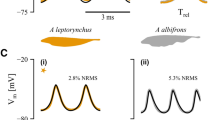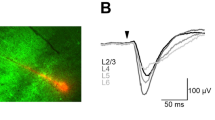Abstract
A SYNCHRONOUS afferent volley initiates a series of rhythmic discharges in the ventrolateral nucleus in the thalamus1, due to repetitive activity in a recurrent inhibitory pathway of the thalamic neurones2. A similar pattern of rhythmic activity occurs spontaneously in animals anæsthetized with barbiturates. An inhibitory phasing theory has been offered as an explanation for the spontaneous rhythm3. According to this theory, a period of rhythmic activity, usually lasting 1–2 sec, is triggered off by the discharge of one cell, which, through a recurrent inhibitory pathway utilizing one or several interneurones, is producing inhibitory postsynaptie potentials in a number of neighbouring cells. When the inhibitory potentials subside, the neurones will be in a state of post-anodal exaltation, often leading to depolarization of the cell with discharges. Similar depolarizing potentials have been seen in response to hyperpolarizing pulses4–6 or inhibitory postsynaptic potentials7,8 in many types of neurones. In the thalamus, the post-inhibitory firing will initiate another cycle, engaging an increased number of cells, and so on, until a large proportion of the neurones in a group beat in unison. At this point, a cell, discharging prematurely, may recruit other neurones to discharge at its own rhythm, and thereby start the disruption of the dominant rhythm.
This is a preview of subscription content, access via your institution
Access options
Subscribe to this journal
Receive 51 print issues and online access
$199.00 per year
only $3.90 per issue
Buy this article
- Purchase on Springer Link
- Instant access to full article PDF
Prices may be subject to local taxes which are calculated during checkout
Similar content being viewed by others
References
Adrian, E. D., J. Physiol., 100, 159 (1941).
Andersen, P., and Eccles, J. C., Nature, 196, 645 (1962).
Andersen, P., and Sears, T. A., J. Physiol. (in the press).
Ito, M., Jap. J. Physiol., 7, 297 (1957).
Coombs, J. S., Curtis, D. R., and Eccles, J. C., J. Physiol., 145, 505 (1959).
Araki, T., Ito, M., and Oshima, T., Nature, 191, 1104 (1961).
Coombs, J. S., Eccles, J. C., and Fatt, P., J. Physiol., 130, 291 (1955).
Kandel, E. R., and Spencer, W. A., J. Neurophysiol., 24, 243 (1961).
Andersen, P., Brooks, C. McC., Eccles, J. C., and Sears, T. A., J. Physiol. (in the press).
Author information
Authors and Affiliations
Rights and permissions
About this article
Cite this article
ANDERSEN, P., RUDJORD, T. Simulation of a Neuronal Network operating Rhythmically through Recurrent Inhibition. Nature 204, 289–290 (1964). https://doi.org/10.1038/204289a0
Published:
Issue Date:
DOI: https://doi.org/10.1038/204289a0
This article is cited by
-
Neural network implementation of a three-phase model of respiratory rhythm generation
Biological Cybernetics (1990)
-
Mechanism of the influence of the reticular formation on cortical neurons
Neuroscience Translations (1967)
Comments
By submitting a comment you agree to abide by our Terms and Community Guidelines. If you find something abusive or that does not comply with our terms or guidelines please flag it as inappropriate.



